1997 CHEVROLET CORVETTE mirror
[x] Cancel search: mirrorPage 159 of 356
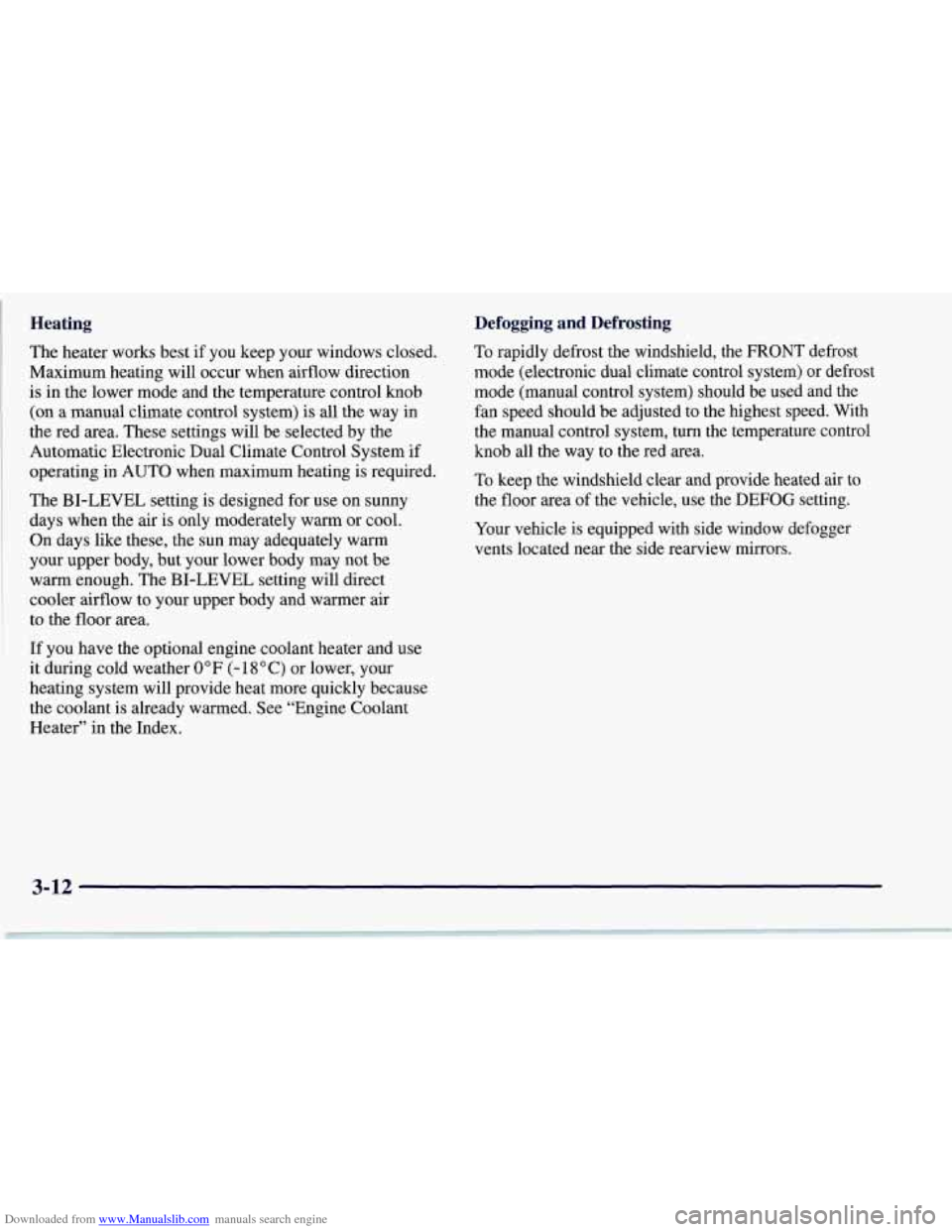
Downloaded from www.Manualslib.com manuals search engine Heating
The heater works best if you keep your windows closed.
Maximum heating will occur when airflow direction
is in the lower mode and the temperature control knob
(on a manual climate control system) is all the way in
the red area. These settings will be selected by the
Automatic Electronic Dual Climate Control System if
operating in AUTO when maximum heating is required.
The BI-LEVEL setting is designed for use on sunny
days when the air is only moderately warm or cool.
On days like these, the sun may adequately warm
your upper body, but your lower body may not be
warm enough. The BI-LEVEL setting will direct
cooler airflow to your upper body and warmer air
to the floor area.
If you have the optional engine coolant heater and use
it during cold weather
0°F (- 18OC) or lower, your
heating system will provide heat more quickly because
the coolant is already warmed. See “Engine Coolant
Heater” in the Index.
Defogging and Defrosting
To rapidly defrost the windshield, the FRONT defrost
mode (electronic dual climate control system) or defrost
mode (manual control system) should be used and the
fan speed should be adjusted to the highest speed. With
the manual control system,
turn the temperature control
knob all the way to the red area.
To keep the windshield clear and provide heated air to
the floor area of
the vehicle, use the DEFOG setting.
Your vehicle is equipped with side window defogger
vents located near the side rearview mirrors.
3-12
Page 193 of 356
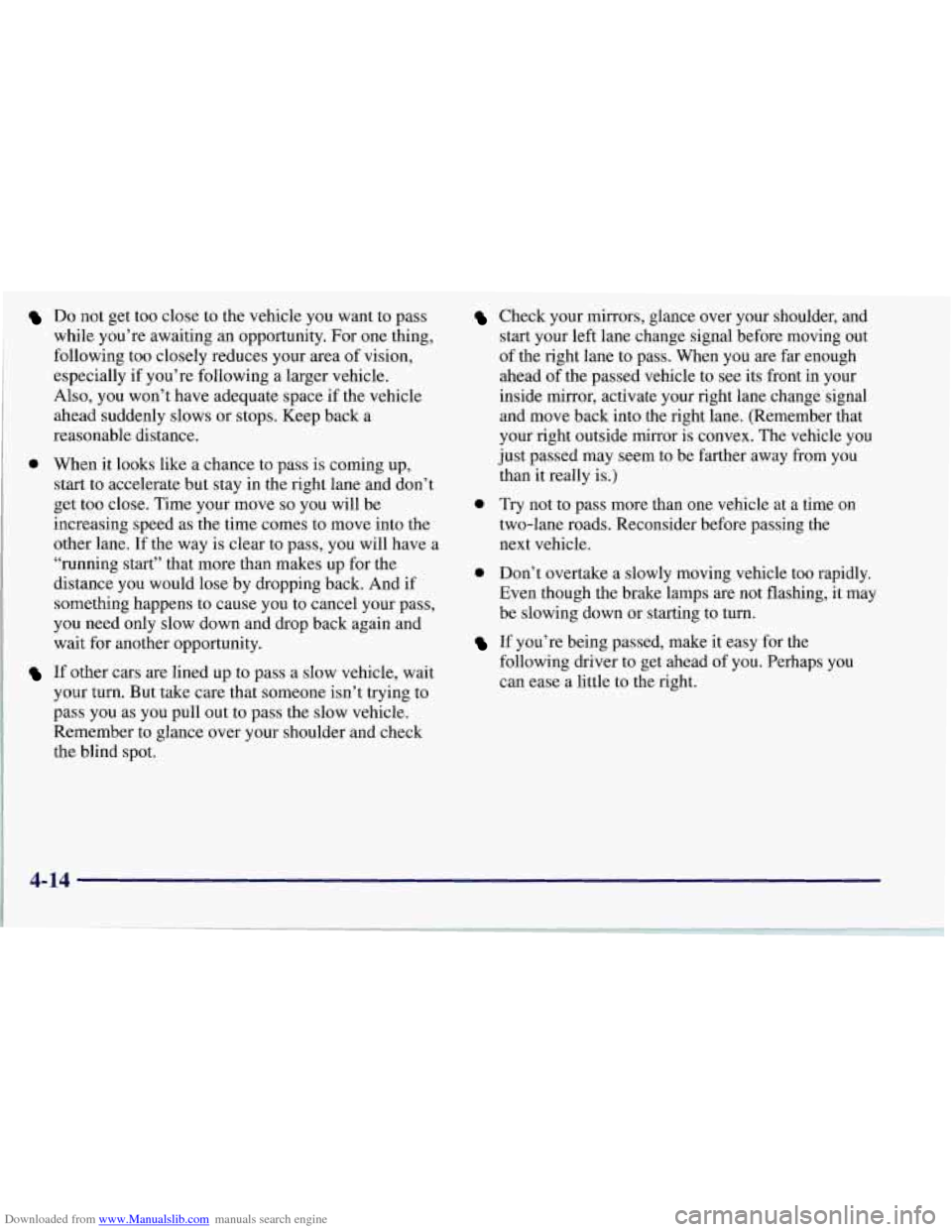
Downloaded from www.Manualslib.com manuals search engine Do not get too close to the vehicle you want to pass
while you’re awaiting an opportunity.
For one thing,
following too closely reduces your area of vision,
especially if you’re following a larger vehicle.
Also, you won’t have adequate space if the vehicle
ahead suddenly slows
or stops. Keep back a
reasonable distance.
0 When it looks like a chance to pass is coming up,
start to accelerate but stay in the right lane and don’t
get too close. Time your move
so you will be
increasing speed as the time comes to move into the
other lane. If the way
is clear to pass, you will have a
“running start” that more than makes up for the
distance you would lose by dropping back. And if
something happens to cause you to cancel your pass,
you need only slow down and drop back again and
wait for another opportunity.
If other cars are lined up to pass a slow vehicle, wait
your turn. But take care that someone isn’t trying to
pass you as you pull out to pass the slow vehicle.
Remember to glance over your shoulder and check
the blind spot.
Check your mirrors, glance over your shoulder, and
start your left lane change signal before moving out
of the right lane to pass. When you are far enough
ahead of the passed vehicle to see its front in your
inside mirror, activate your right lane change signal
and move back into the right lane. (Remember that
your right outside mirror is convex. The vehicle you
just passed may seem to be farther away from you
than it really is.)
0 Try not to pass more than one vehicle at a time on
two-lane roads. Reconsider before passing the
next vehicle.
0 Don’t overtake a slowly moving vehicle too rapidly.
Even though the brake lamps
are not flashing, it may
be slowing down or starting to turn.
If you’re being passed, make it easy for the
following driver to get ahead of you. Perhaps you
can ease a little to the right.
4-14
Page 194 of 356
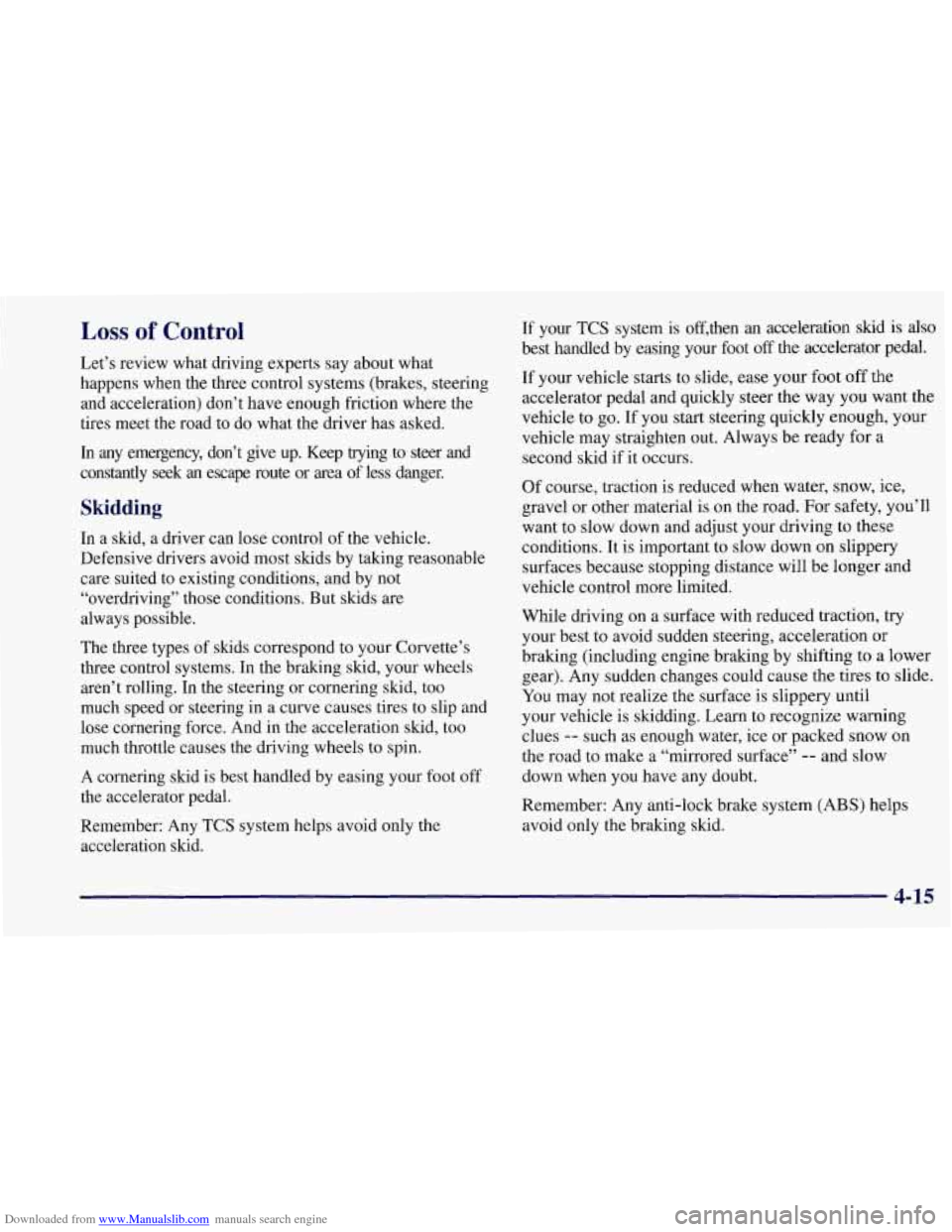
Downloaded from www.Manualslib.com manuals search engine Loss of Control
Let’s review what driving experts say about what
happens when the three control systems (brakes, steering
and acceleration) don’t have enough friction where the
tires meet the road to do what the driver has asked.
In any emergency, don’t give up. Keep trying to steer and
constantly seek an escape route or area of less danger.
Skidding
In a skid, a driver can lose control of the vehicle.
Defensive drivers avoid most skids by taking reasonable
care suited to existing conditions, and by not
“overdriving” those conditions. But skids are
always possible.
The three types of skids correspond to your Corvette’s
three control systems. In the braking skid, your wheels
aren’t rolling. In the steering or cornering skid, too
much speed or steering in a curve causes tires to slip and
lose cornering force. And
in the acceleration skid, too
much throttle causes the driving wheels to spin.
A cornering skid is best handled by easing your foot
off
the accelerator pedal.
Remember: Any TCS system helps avoid only the
acceleration shd.
If your TCS system is off,then an acceleration skid is also
best handled by easing your foot off the accelerator pedal.
If your vehicle starts to slide, ease your foot
off the
accelerator pedal and quickly steer the way you want the
vehicle to go. If you start steering quickly enough, your
vehicle may straighten out. Always be ready for a
second skid if it occurs.
Of course, traction is reduced when water, snow, ice,
gravel
or other material is on the road. For safety, you’ll
want to slow down and adjust your driving to these
conditions. It
is important to slow down on slippery
surfaces because stopping distance will
be longer and
vehicle control more limited.
While driving on a surface with reduced traction, try
your best to avoid sudden steering, acceleration or
braking (including engine braking by shifting to a lower
gear). Any sudden changes could cause the tires to slide.
You may not realize the surface is slippery until
your vehicle is skidding. Learn to recognize warning
clues
-- such as enough water, ice or packed snow on
the road to make a “mirrored surface”
-- and slow
down when you have any doubt.
Remember: Any anti-lock brake system
(ABS) helps
avoid only the bralung skid.
4-15
Page 195 of 356
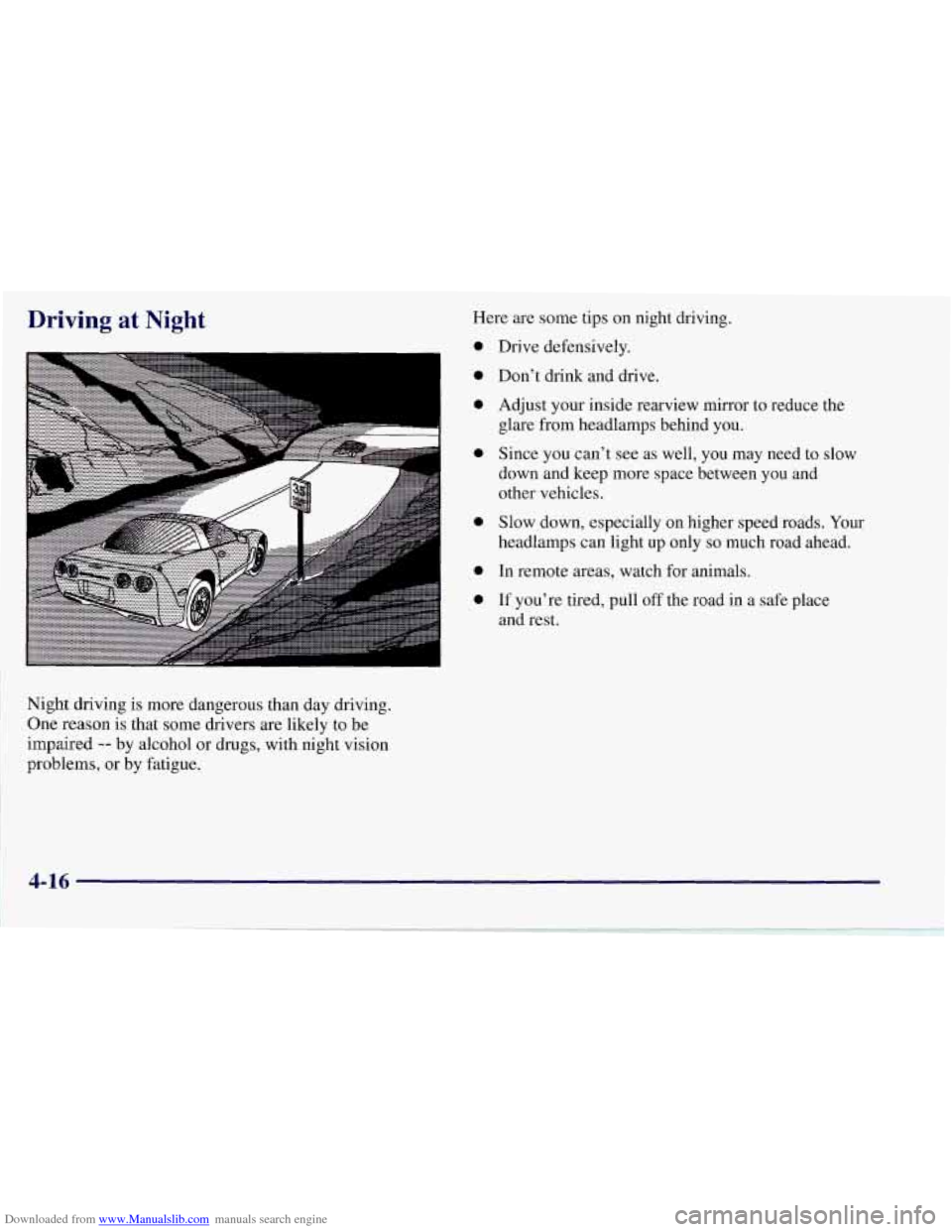
Downloaded from www.Manualslib.com manuals search engine Driving at Night
I
Night driving is more dangerous than day driving.
One reason is that some drivers are likely to be
impaired
-- by alcohol or drugs, with night vision
problems, or by fatigue. Here
are some tips on night driving.
0
0
0
0
0
0
0
Drive defensively.
Don’t drink and drive.
Adjust your inside rearview mirror to reduce the
glare from headlamps behind you.
Since you can’t
see as well, you may need to slow
down and keep more space between you and
other vehicles.
Slow down, especially on higher speed roads. Your
headlamps can light up only
so much road ahead.
In remote areas, watch for animals.
If you’re tired, pull
off the road in a safe place
and rest.
4-16
Page 201 of 356
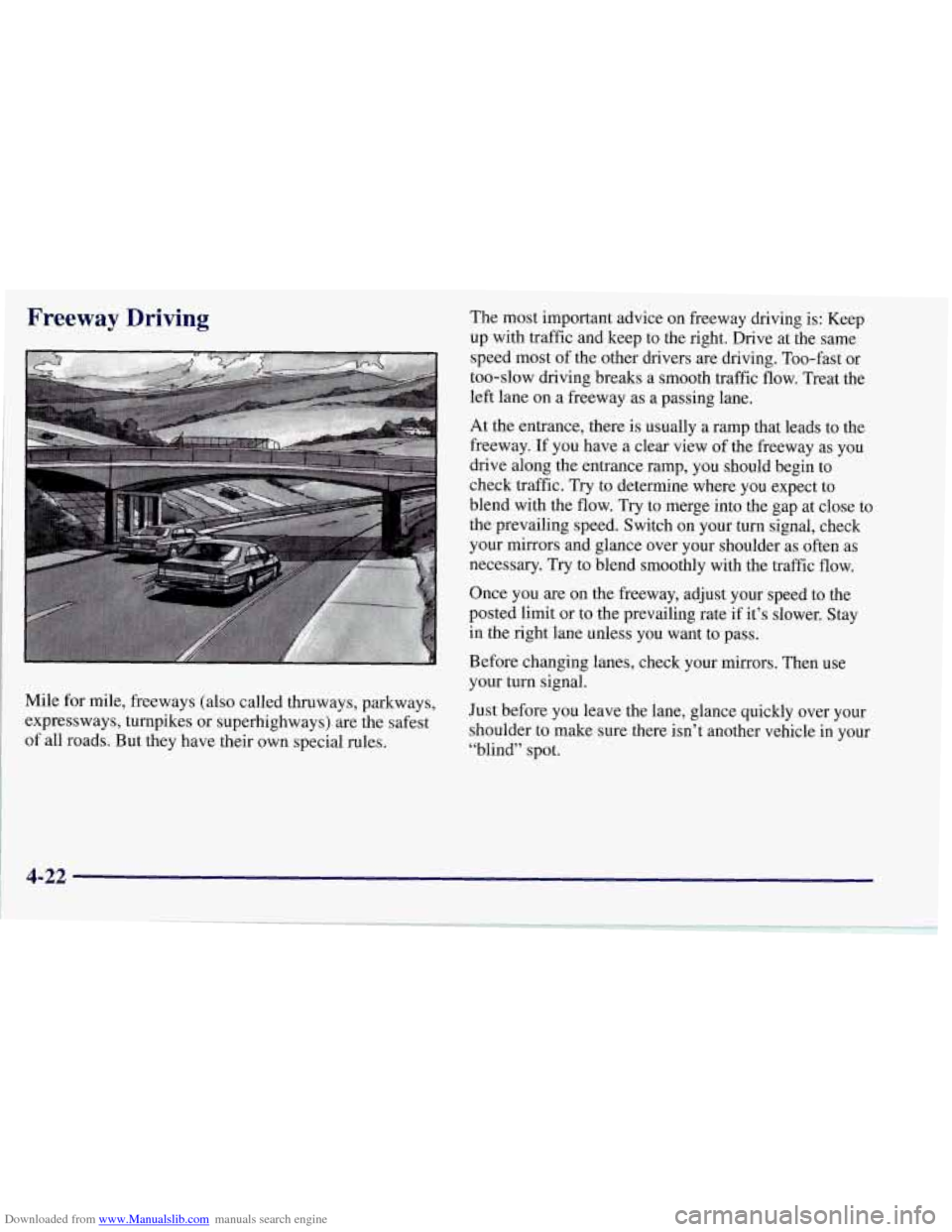
Downloaded from www.Manualslib.com manuals search engine Freeway Driving
Mile for mile, freeways (also called thruways, parkways,
expressways, turnpikes or superhighways) are the safest
of all roads. But they have their own special rules. The
most important advice on freeway driving is: Keep
up with traffic and keep to the right. Drive at the same
speed most
of the other drivers are driving. Too-fast or
too-slow driving breaks a smooth traffic flow. Treat the
left lane on a freeway as a passing lane.
At the entrance, there
is usually a ramp that leads to the
freeway.
If you have a clear view of the freeway as you
drive along the entrance ramp, you should begin to
check traffic. Try to determine where you expect to
blend with the flow. Try to merge into the gap at close to the prevailing speed. Switch on your turn signal, check
your mirrors and glance over your shoulder as often as
necessary. Try to blend smoothly with the traffic flow.
Once you
are on the freeway, adjust your speed to the
posted limit or to the prevailing rate
if it’s slower. Stay
in the right lane unless you want to pass.
Before changing lanes, check your mirrors. Then use
your turn signal.
Just before you leave the lane, glance quickly over your
shoulder to make sure there isn’t another vehicle in your
“blind” spot.
4-22
Page 203 of 356
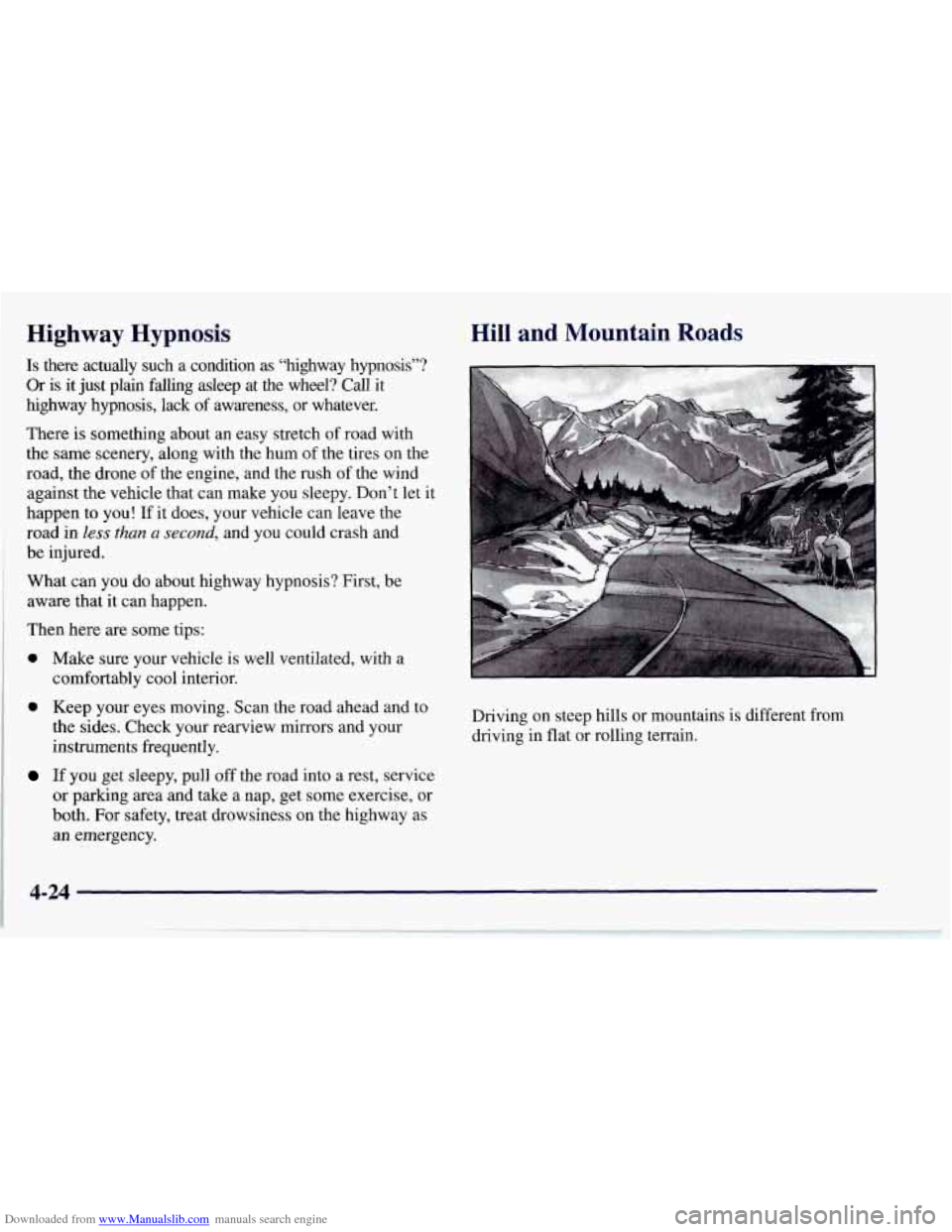
Downloaded from www.Manualslib.com manuals search engine Highway Hypnosis
Is there actually such a condition as “highway hypnosis”? \
Or is it just plain falling asleep at the wheel? Call it
highway hypnosis, lack
of awareness, or whatever.
There is something about an easy stretch of road with
the same scenery, along with the hum of the tires on the
road, the drone of the engine, and the rush of the wind
against the vehicle that can make you sleepy. Don’t let it
happen to you! If it does, your vehicle can leave the
road
in less than a second, and you could crash and
be injured.
What can
you do about highway hypnosis? First, be
aware that it can happen.
Then here are some tips:
0 Make sure your vehicle is well ventilated, with a
comfortably cool interior.
0 Keep your eyes moving. Scan the road ahead and to
the sides. Check your rearview mirrors and your
instruments frequently.
If you get sleepy, pull off the road into a rest, service
or parking area and take a nap, get some exercise, or
both. For safety, treat drowsiness on
the highway as
an emergency.
Hill and Mountain Roads
Driving on steep hills or mountains is different from
driving in flat
or rolling terrain.
4-24
Page 304 of 356
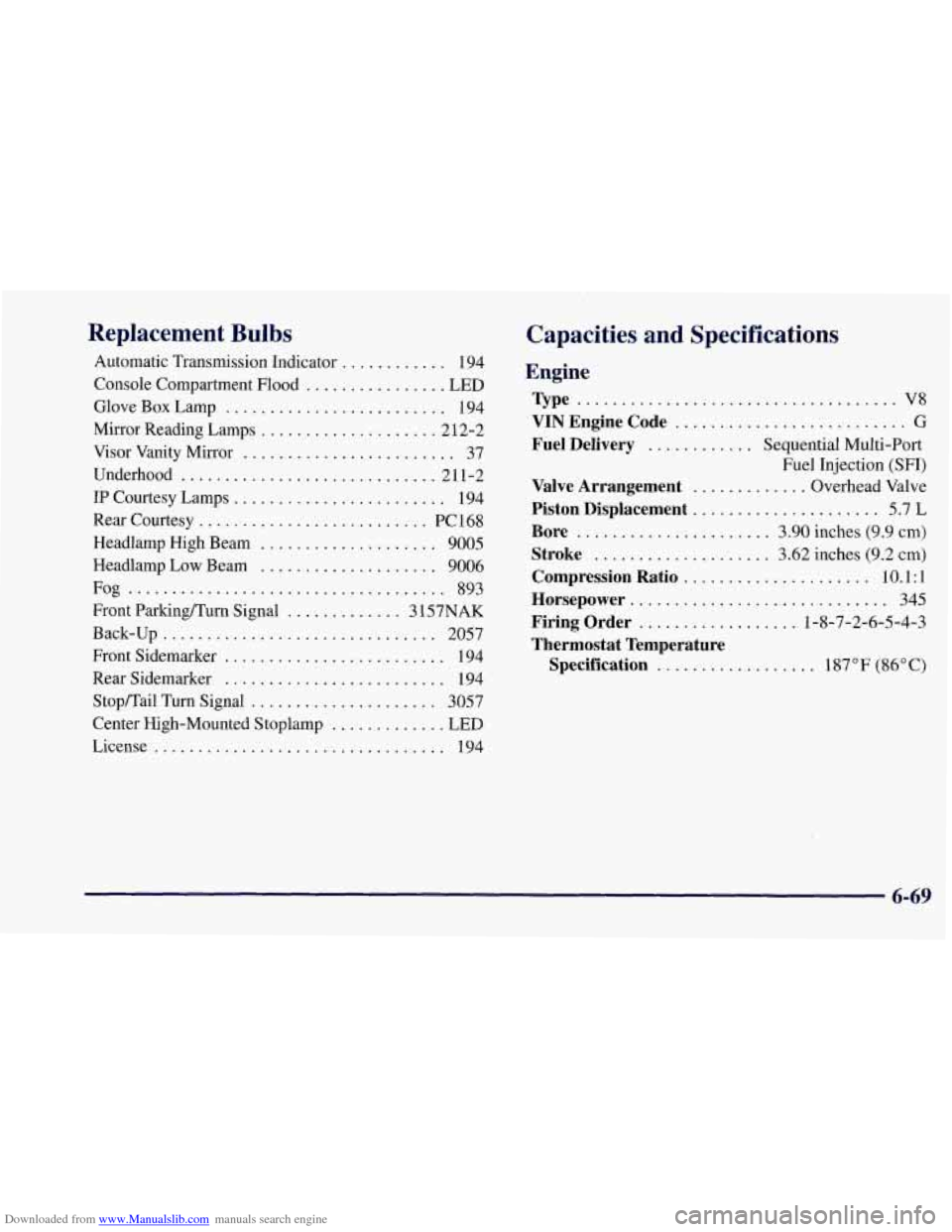
Downloaded from www.Manualslib.com manuals search engine Replacement Bulbs
Automatic Transmission Indicator ............ 194
Console Compartment Flood
................ LED
Glove Box Lamp ......................... 194
Mirror Reading Lamps
.................... 212-2
Visor Vanity Mirror
........................ 37
Underhood
............................. 211-2
IP Courtesy Lamps
........................ 194
Headlamp High Beam
.................... 9005
Headlamp Low Beam .................... 9006
Fog .................................... 893
Rear Courtesy .......................... PC168
Front ParlunglTurn Signal
............. 3 157NAK
Back-up
............................... 2057
Front Sidemarker
......................... 194
Rear Sidemarker
......................... 194
Stopflail Turn Signal
..................... 3057
Center High-Mounted Stoplamp
............. LED
License
................................. 194
Capacities and Specifications
Engine
Type .................................... V8
Fuel Delivery ............ Sequential Multi-Port
VIN Engine Code .......................... G
Fuel Injection (SFI)
Valve Arrangement ............. Overhead Valve
Piston Displacement ..................... 5.7 L
Bore ...................... 3.90 inches (9.9 cm)
Stroke .................... 3.62 inches (9.2 cm)
Compression Ratio ..................... 10.1 : 1
Horsepower ............................. 345
Firing Order .................. 1-8-7-2-6-5-4-3
Thermostat Temperature
Specification
.................. 1 87 O F (86 O C)
6-69
Page 346 of 356
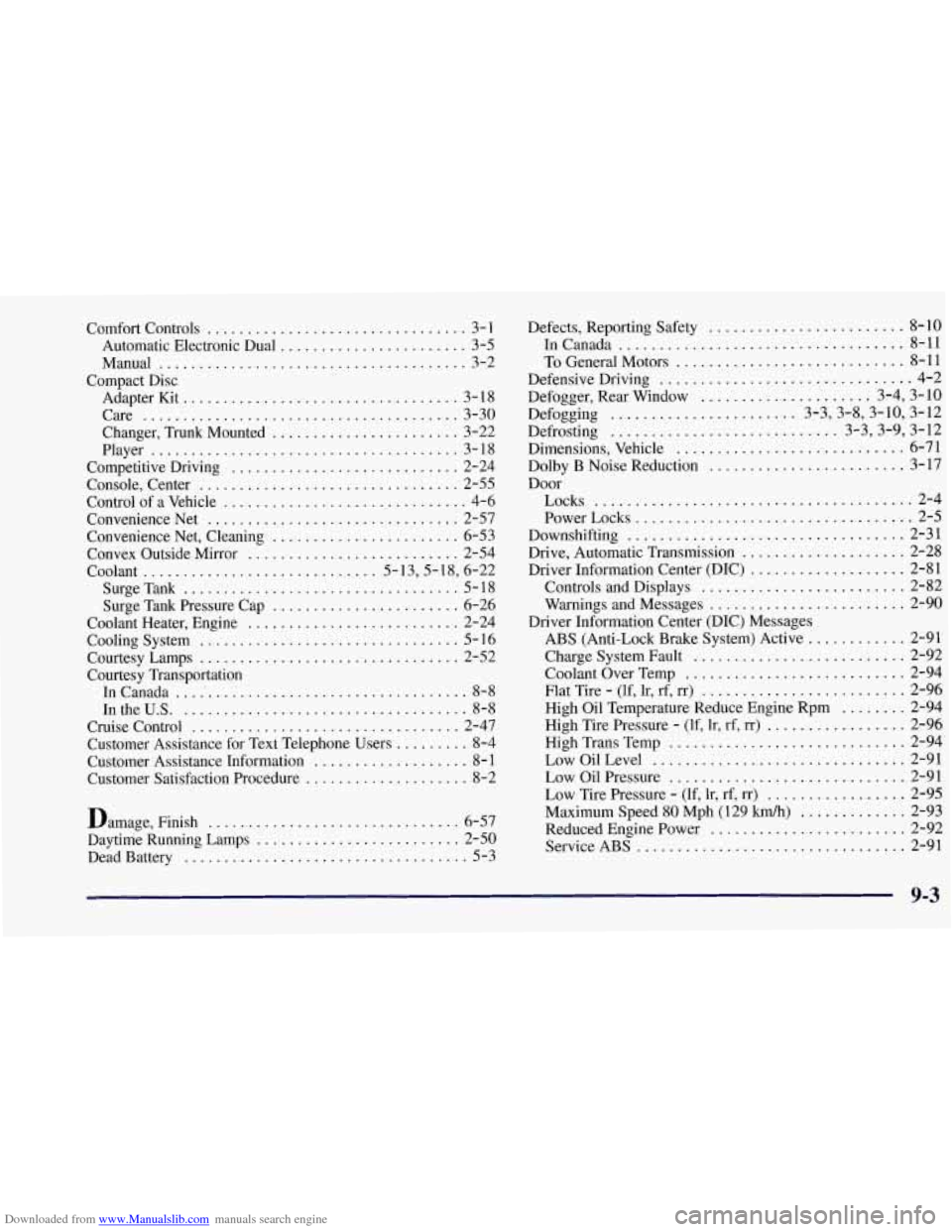
Downloaded from www.Manualslib.com manuals search engine Comfort Controls ................................ 3- 1
Automatic Electronic Dual ....................... 3-5
Manual
...................................... 3-2
Adapter Kit
.................................. 3-18
Care
....................................... 3-30
Changer, Trunk Mounted
....................... 3-22
Player
...................................... 3-18
Competitive Driving ............................ 2-24
Console, Center
................................ 2-55
Control of a Vehicle
.............................. 4-6
Convenience Net
............................... 2-57
Convenience Net, Cleaning
....................... 6-53
Convex Outside Mirror
.......................... 2-54
Coolant
............................. 5-13,5-18, 6-22
SurgeTank
.................................. 5-18
Surge Tank Pressure Cap
....................... 6-26
Coolant Heater, Engine
.......................... 2-24
Cooling System
................................ 5- 16
CourtesyLamps
................................ 2-52
Courtesy Transportation
In Canada
..................................... 8-8
1ntheU.S. ................................... 8-8
Cruise Control ................................. 2-47
Customer Assistance for Text Telephone Users
......... 8-4
Customer Assistance Information
................... 8- 1
Customer Satisfaction Procedure .................... 8-2
Compact Disc
Damage. Finish
............................... 6-57
Daytime Running Lamps
......................... 2-50
Dead Battery
................................... 5-3 Defects. Reporting Safety
........................ 8-10
InCanada
................................... 8-11
To General Motors ............................ 8-11
Defensive Driving
............................... 4-2
Defogger. Rear Window
..................... 3.4. 3.10
Defogging
....................... 3.3.3.8.3.10. 3.12
Defrosting
............................ 3.3.3.9. 3.12
Dimensions. Vehicle
............................ 6-71
Dolby
B Noise Reduction ........................ 3-17
Door Locks
....................................... 2-4
PowerLocks
.................................. 2-5
Downshifting
.................................. 2-31
Drive, Automatic Transmission
.................... 2-28
Driver Information Center (DIC)
................... 2-81
Controls and Displays
......................... 2-82
Warnings and Messages
........................ 2-90
ABS (Anti-Lock Brake System) Active
............ 2-91
Charge System Fault
.......................... 2-92
Coolant Over Temp
........................... 2-94
Flat Tire
- (If, lr, rf, rr) ......................... 2-96
High Oil Temperature Reduce Engine Rpm
........ 2-94
High Tire Pressure
- (If. Ir, rf. IT) ................. 2-96
High Trans Temp
............................. 2-94
LowOilLevel
............................... 2-91
Low Oil Pressure
............................. 2-91
Low Tire Pressure
- (If, lr. rf, rr) ................. 2-95
Maximum Speed 80 Mph (129
Mh) ............. 2-93
Reduced Engine Power
........................ 2-92
Service ABS
................................. 2-91
Driver Information Center
(DIC) Messages
9-3